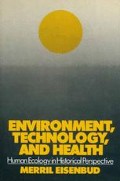Abstract
The food we eat, the homes in which we live, our educational system, our leisure-time activities, and the medical services essential to our health all require access to sources of energy. Energy relieves us of the stressful effects of climate, it enables us to grow food in amounts adequate to fulfill the needs of growing populations, it greatly reduces the constraints of distance on communication and transportation, and it brings to the home of the average person leisure time and relative luxury on a scale unprecedented in history.
Preview
Unable to display preview. Download preview PDF.
Notes
Makhijani, Arjun. “Energy and Agriculture in the Third World: A Report to the Energy Policy Project of the Ford Foundation,” Ballinger Publishing Co., Cambridge, Mass. (1975).
Starr, Chauncey and Stanford Field. “Energy Use Proficiency: The Validity of Interregional Comparisons,” Electric Power Research Institute, Palo Alto, Cal. (March, 1977 ).
Darmstadter, Joel, Joy Dunkerly and Jack Ackerman. “How Industrial Societies Use Energy,” The Johns Hopkins Univ. Press, Baltimore, Md. (1977).
Brown, Harrison, James Bonner and John Weir. “The Next Hundred Years,” Weidenfeld and Nicolson, London (1957).
Hubbert, M. King. “Energy Resources,” Report to the Committee on Natural Resources of NAS-NRC, Publication 1000-D, National Academy of Sciences-National Research Council, Washington, D. C. (1962).
Hubbert, M. King. “Energy Resources,” in: “Resources and Man,” W. H. Freeman and Co., San Francisco, Cal. (1969), p. 204.
Ehrlich, Paul R. and Anne H. Ehrlich. “Population Resources Environment: Issues in Human Ecology,” 2nd ed., W. H. Freeman and Co., San Francisco, Cal. (1972).
Ford Foundation. “Exploring Energy Choices: A Preliminary Report,” The Ford Foundation Energy Policy Project, Washington, D. C. (1974).
Enterline, Philip E. “A Review of Mortality Data for American Coal Miners,” in: “Coal Workers’ Pneumoconiosis” (I.J. Selikoff, M.M. Key and D.H.K. Lee, eds.), Annals of the New York Academy of Sciences. 200:260 (1972).
Dessauer, P., E. J., Baier, G. M., Crawford and J. A. Beatty. “Development of Patterns of Coal Workers’ Pneumoconiosis in Pennsylvania and Its Association with Respiratory Impairment,” in: “Coal Workers’ Pneumoconiosis” (I. J. Selikoff, M. M. Key and D. H. K. Lee, eds.), Annals of the New York Academy of Sciences 200:220 (1972).
Osborn, E. F. “Coal and the Present Energy Situation,” Science 183: 477 (1974).
Hammond, A. L., W. D. Metz and T. H. Maugh. “Energy and the Future,” American Association for the Advancement of Science, Washington, D. C. (1973).
Squires, A. M. “Clean Fuels from Coal Gasification,” Science 184: 340346 (1974).
Hammond, Allen L. “Coal Research (II): Gasification Faces an Uncertain Future,” Science 193: 750–753 (1976).
Osborn, E. F. “Coal and The Present Energy Situation,” Science 183: 477 (1974).
Franssen, H. T. “Towards Project Interdependence: Energy in the Coming Decade,” prepared for the Joint Committee on Atomic Energy, U. S. Congress. U.S. Government Printing Office, Washington, D.C. (December, 1975 ).
Kash, D. E., I. L. White, K. H. Bergey, M. A. Chartock, M. D. Devine, R. L. Leonard, S. N. Salomon and H. W. Young. “Energy under the Oceans: A Technology Assessment of Outer Continental Shelf Oil and Gas Operations,” Univ. of Oklahoma Press, Norman, Okla. (1973).
Travers, William B. and Percy R. Luney. “Drilling, Tankers, and Oil Spills on the Atlantic Outer Continental Shelf,” Science 194: 791–795 (1976).
Lieberman, M. A. “United States Uranium Resources-An Analysis of Historical Data,” Science 192: 431 (1976).
Ford Foundation. “Nuclear Power Issues and Choices,” Report of the Nuclear Energy Policy Study Group, Ballinger Publishing Co., Cambridge, Mass. (1977).
Post, R. F. and F. L. Ribe. “Fusion Reactors as Future Energy Sources,” Science 186 (4162): 397 (1974).
Electric Power Research Institute. “Assessment of Laser-Driven Fusion: Final Report,” EPRI ER-203, Palo Alto, Cal. (September, 1976 ).
Isaacson, L. K. “Laser-Fusion Program: Summary Report,” EPRI SR-9, Special Report, Electric Power Research Institute, Palo Alto, Cal. (1975)
Metz, W. D. “What Can the Academic Community Do?” Science 184: 273–278 (1974).
Landsberg, H. H. “Low-Cost, Abundant Energy: Paradise Lost?” Science 184: 247–253 (1974).
U.S. ERDA. “Information from ERDA: Reference Information” (Special Issue), Washington D.C. (May, 1977 ).
Wade, Nicholas. “Windmills: The Resurrection of an Ancient Energy Technology,” in: “Energy: Use Conservation and Supply” ( Philip H. Abelson, ed.), Washington, D.C. (1974), p. 128.
Calvin, M. “Solar Energy by Photosynthesis,” Science 184 (4134): 375 (1974).
Reed, T. B. and R. M. Lerner. “Methanol: a Versatile Fuel for Immediate Use,” Science 182: 1299 (1973).
Anderson, L. L. “Energy Potential from Organic Wastes: A Review of the Quantities and Sources,” Bureau of Mines Information Circular 8549, U.S. Government Printing Office, Washington, D.C. (1972).
Othmer, D. F. and O. A. Roels. “Power, Fresh Water, and Food from Cold, Deep Sea Water,” Science 182: 121 (1973).
Atomic Industrial Forum, Inc. “Geothermal Energy,” AIF Background Info, Atomic Industrial Forum, Inc., Washington, D. C. (November, 1975 ).
Axtmann, Robert C. “Environmental Impact of a Geothermal Power Plant,” Science 187 (4179): 795 (1975).
Darmstadter, J. “Conserving Energy: Prospects and Opportunities in the New York Region,” Johns Hopkins Univ. Press, Baltimore, Md. (1975).
Rand Corporation. “Energy Use and Conservation in the Residential Sector: A Regional Analysis,” R-1641-NSF, Santa Monica, Cal. (1975).
Hirst, Eric. “Residential Energy Use Alternatives: 1976 to 2000,” Science 194: 1247–1252 (1976).
Smith, C. B. “An Energy-Constrained Society,” in: “Efficient Energy Use” (C. B. Smith, ed.), Pergamon Press, Elmsford, N.Y. (1976).
Fazzolare, R. “Industrial Energy Use,” in: “Efficient Energy Use” (C. B. Smith, ed.), Pergamon Press, Elmsford, N.Y. (1976).
Taussig, R. T. and C. B. Smith. “Commercial Energy Use,” in: “Efficient Energy Use” (C. B. Smith, ed.), Pergamon Press, Elmsford, N.Y. (1976).
Copyright information
© 1978 New York University
About this chapter
Cite this chapter
Eisenbud, M. (1978). Energy Supply and Demand. In: Environment, Technology, and Health. Palgrave, London. https://doi.org/10.1007/978-1-349-04752-9_6
Download citation
DOI: https://doi.org/10.1007/978-1-349-04752-9_6
Publisher Name: Palgrave, London
Print ISBN: 978-1-349-04754-3
Online ISBN: 978-1-349-04752-9
eBook Packages: Palgrave Social & Cultural Studies CollectionSocial Sciences (R0)

